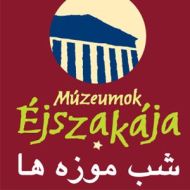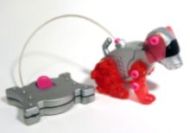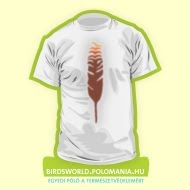A csudatévő csengettyű
Trisztán Velszbe bujdosott, a nemes Gilanus herceg országába. Ifjú volt a herceg, hatalmas, jószívű. Úgy fogadta Trisztánt, mint szívesen látott jövevényt. Vendégének tisztességét, örömét keresvén, fáradságot nem kímélt; de sem kalandok, sem dínom-dánom nem oszlathatták Trisztán szíve szorongását.
Egyszer az ifjú herceg mellett ülvén úgy fájt Trisztán szíve, hogy − maga sem vette észre − felsóhajtott. Hogy kínját enyhítené Trisztánnak, parancsolá a herceg, hozzák belső szobájába kedves mulatságát, ki a kedvetlen órákon valami varázslat által szemét-szívét elbűvölte. Nemes, drága bíborral borított asztalra behozták kutyáját, Mákszemet. Elvarázsolt eb vala ez: Avallon sziget hercegétől jött, kinek szerelemzálogul egy tündér küldötte volt. A gyakorlott toll is gyarló rendre leírni, hogy mit tud, s mily gyönyörű jószág. Szőre különb-különb csodás árnyalatokban pompázó, színét nehéz megnevezni: nyaka fehérebb a hónál, fara lóherénél zöldebb, egy oldala skarlátpiros, más oldala sáfránysárga, hasa kék, mint a lazurkő, rózsaszín a háta. Ha ki minél tovább nézi, szeme is kaprodzik tőle, mintha váltaná a színét hol fehérre, hol meg zöldre, sárgára, kékre, bíborra, sötétre meg haloványra. Nyakában, kis aranyláncon, tiszta hangú, szelíd szavú, csilingelő csengettyű. Hallatára Trisztán búja oszlott, szíve békélt, csillapult. Már feledte Izoldáért viselt gyakor gyötrelmeit, mert az volt a csengettyűnek csudatévő ereje: ha ki hallá szelíden és vígan csilingelni, feledt minden bánatot. Bűvölten a boszorkányosságtól, Trisztán cirógatta a kis elvarázsolt állatot, ki elvette búját. Lám, bundája, mint a bársony, puha tapintású. Izoldának szép ajándék lenne − így gondolta Trisztán. De mitévő legyen? Gilanus herceg Mákszemet mindenekfölött szerette. Tőle csellel azt kicsalni, könyörgéssel kicsikarni merő lehetetlen.
Egyszer így szólt a herceghez Trisztán:
− Fenség, mi jutalmat venne, ha kiországodat megszabadítaná a torzonborz Urgantól, amaz óriástól, ki téged sarcol és sanyargat?
− Bizony, ki Urgant legyőzné, választhatna kincseimből, még a legbecsesbet is. De az óriással kiállni senkifia nem mer.
− Ez már beszéd. − mondta Trisztán. − Hanem vitéz vállalkozás nélkül ország sorsa jóra sose fordul, s én nem adnám Páviának minden aranyáért, ha azzal az óriással megvíhatnék.
− Vezéreljen hát Isten, a Szűztől született, s óvjon meg a haláltól.
Barlangjában érte Trisztán a Torzonborz Urgant. Soká tartott az ádáz viadal. Végtére is a vitézség erőt győzött, a fürge kard súlyos buzogányt. Levágván az óriás jobbját, Trisztán hazavitte a hercegnek:
− Fenség, jutalmamul, ígéreted szerint addsza nekem nekem elvarázsolt kutyádat, Mákszemet.
− Mit kértél, barátom? Hagyd nekem őt; vedd el inkább húgomat és fele birodalmam.
− Fenség, húgod gyönyörű és gyönyörű a földed; hanem én tündérkutyádért támadtam meg a Torzonborz Urgant. Emlékezzél csak ígéretedre!
− Fogd hát; de tudd, hogy szememnek örömét vetted el, szívem vigasságát!
Trisztán rábízta a kutyát egy velszi igricre, okos agyafúrt emberre, hogy Kornvallba vinné. Eljutott az igric Tintagelbe, titkon általadta Brangiennek. Örült és örvendezett Izolda, tíz márka aranyat adott jutalmul az igricnek, s a királynak azt mondotta, hogy a drága ajándokot asszonyanyja, a királyné küldte Írországból. Ötvös készíté a kutyaházat vert aranyból, drágakövekkel kirakva, s kedvesére emlékeztetőül mindig magával vitte Izolda. És hacsak ránézett: szomorúság, bánat, fájdalom elzsongult szívében.
Elsőbb nem értette a csodát: azt hitte, azért oly jóleső ránézni, mert Trisztántól való: lám, reá gondolván, fájdalma szenderül. De egy napon megismeré, hogy mindez varázslat: csak a csilingelő csengő bűvöli a szívét.
„Jaj − gondolta akkor −, illik-e, hogy nyugalmat találjak, ha Trisztán boldogtalan? Elvarázsolt ebét megtarthatta volna, ekként minden fájdalmát is feledhette volna. Szíves szolgálattal mégis inkább nekem küldte, nekem adta örömét s a bút magára vevén. Hanem ez nem való: hadd gyötrődjem, Trisztán, én is, te gyötrelmediglen!”
Fogta a csodacsengettyűt, utolsót csilingelt vele, szelíden leoldá, és a nyitott ablakon át kihajítá a tengerbe.
(Joseph Bédier: Trisztán és Izolda regéje, fordította: Pap Gábor)
The little fairy bell
When Tristan had come back to Orri’s hut, and had loosened his heavy pilgrim’s cape, he saw clearly in his heart that it was time to keep his oath to King Mark and to fly the land.
Three days yet he tarried, because he could not drag himself away from that earth, but on the fourth day he thanked the woodman, and said to Gorvenal:
“Master, the hour is come.”
And he went into Wales, into the land of the great Duke Gilain, who was young, powerful, and frank in spirit, and welcomed him nobly as a God-sent guest.
And he did everything to give him honour and joy; but he found that neither adventure, nor feast could soothe what Tristan suffered.
One day, as he sat by the young Duke’s side, his spirit weighed upon him, so that not knowing it he groaned, and the Duke, to soothe him, ordered into his private room a fairy thing, which pleased his eyes when he was sad and relieved his own heart; it was a dog, and the varlets brought it in to him, and they put it upon a table there. Now this dog was a fairy dog, and came from the Duke of Avalon; for a fairy had given it him as a love-gift, and no one can well describe its kind or beauty. And it bore at its neck, hung to a little chain of gold, a little bell; and that tinkled so gaily, and so clear and so soft, that as Tristan heard it, he was soothed, and his anguish melted away, and he forgot all that he had suffered for the Queen; for such was the virtue of the bell and such its property: that whosoever heard it, he lost all pain. And as Tristan stroked the little fairy thing, the dog that took away his sorrow, he saw how delicate it was and fine, and how it had soft hair like samite, and he thought how good a gift it would make for the Queen. But he dared not ask for it right out since he knew that the Duke loved this dog beyond everything in the world, and would yield it to no prayers, nor to wealth, nor to wile; so one day Tristan having made a plan in his mind said this:
“Lord, what would you give to the man who could rid your land of the hairy giant Urgan, that levies such a toll?”
“Truly, the victor might choose what he would, but none will dare.”
Then said Tristan:
“Those are strange words, for good comes to no land save by risk and daring, and not for all the gold of Milan would I renounce my desire to find him in his wood and bring him down.”
Then Tristan went out to find Urgan in his lair, and they fought hard and long, till courage conquered strength, and Tristan, having cut off the giant’s hand, bore it back to the Duke.
And “Sire,” said he, “since I may choose a reward according to your word, give me the little fairy dog. It was for that I conquered Urgan, and your promise stands.”
“Friend,” said the Duke, “take it, then, but in taking it you take away also all my joy.”
Then Tristan took the little fairy dog and gave it in ward to a Welsh harper, who was cunning and who bore it to Cornwall till he came to Tintagel, and having come there put it secretly into Brangien’s hands, and the Queen was so pleased that she gave ten marks of gold to the harper, but she put it about that the Queen of Ireland, her mother, had sent the beast. And she had a goldsmith work a little kennel for him, all jewelled, and incrusted with gold and enamel inlaid; and wherever she went she carried the dog with her in memory of her friend, and as she watched it sadness and anguish and regrets melted out of her heart.
At first she did not guess the marvel, but thought her consolation was because the gift was Tristan’s, till one day she found that it was fairy, and that it was the little bell that charmed her soul; then she thought: “What have I to do with comfort since he is sorrowing? He could have kept it too and have forgotten his sorrow; but with high courtesy he sent it to me to give me his joy and to take up his pain again. Friend, while you suffer, so long will I suffer also.”
And she took the magic bell and shook it just a little, and then by the open window she threw it into the sea.
(The Romance of Tristan & Iseult by Joseph Bédier, rendered into English by Hilaire Belloc)



































